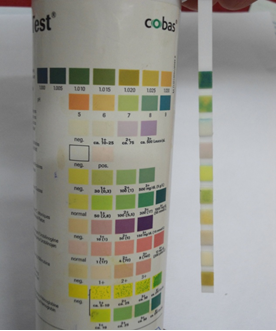Utility of simple dipstick test in diagnosing urinary tract infection in children presenting with fever: A prospective observational study
Abstract
Background: Urinary tract infection (UTI) in children continues to be under-diagnosed, despite its association with renal scarring, hypertension, renal failure, and other sequelae. To avoid these preventable complications, we should treat UTIs in children at the earliest. A simple, reliable, bedside test could solve this problem.
Methods: The study was conducted in a tertiary care hospital as a prospective observational study. The study included 534 children until 12 years of age (excluding neonates), presented with fever without focus or fever with urinary complaints. The Rapid diagnostic urine test was performed with a urine dipstick (Combur 10 test®), for urine nitrite, leukocyte esterase, and protein determination. Simultaneously urine culture was also sent. Sensitivity, Specificity, Positive Predictive Value, Negative Predictive Value, and diagnostic accuracy were calculated. Observations: Urine culture was found positive in 80 cases (14.9 %). When all the three tests were positive, diagnostic accuracy was maximum (90.7%). The diagnostic accuracy of the nitrite test was also > 90%. Furthermore, all three tests have very high negative predictive values (> 87%). Conclusion: If all three tests are positive or only nitrite is positive antibiotic should be started and given a full course of treatment irrespective of the urine culture report. All three tests have very high negative predictive values, which excludes UTI. The rapid diagnostic dipstick will reduce the workload of the laboratory. This may guide the clinician in managing OPD as well as inpatient empirical therapy, as delay or untreated UTI can have long-term future implications.
Downloads
References
Pylkkanen J, Vilska J, Koskimies O. The value of level diagnosis of childhood urinary tract infection in predicting renal injury. Acta Paediatr Scand 1981;70(6):879 –83.
Jacobson SH, Eklof O, Eriksson CG, et al. Development of hypertension and uremia after pyelonephritis in childhood: 27 years follow up. BMJ 1989;299(6701):703– 6.
Revised Statement on Management of Urinary Tract Infection. Indian Society of Pediatric Nephrology. Indian Pediatrics, September 2011, Volume 48, Number 9, Pg 709-717.
Lohr JA, Portillia MG, Gender TG, Dunn ML, Dudley SM. Making a presumptive diagnosis of urinary tract infection by using urinalysis performed in an on-site laboratory. J Pediatr 1993; 122: 22-25.
Shaw KN, Hexter D, McGowan KI, Schwartz JS. Clinical evaluation of a rapid screening test for urinary tract infections in children. J Pediatr 1991; 118: 733-735.
Goldsmith BM, Campos JM. Comparison of urine dipstick, microscopy and culture for the detection of bacteriuria in children. Clin Pediatr 1990; 29: 214-218.
Seema Sood, Pramod Upadhyaya, Arti Kapil, Rakesh Lodha, Yogesh Jain , and Arvind Bagga. An indigenously developed nitrite kit to aid in the diagnosis of urinary tract infection. Indian Pediatrics 1999;36: 887-890
Shaw ST, Poon SY, Wong Et. Routine urinalysis: Is dipstick enough? JAMA 1985; 253: 1596-1600.
Oneson R, Grosehel DHM. Leukocyte esterase activity and nitrite test as a rapid screen for significant bacteriuria. Am J Clin Pathol 1985; 83: 84-87.
Deville W., Yzermans J.C., Duijn N.P., Bezemer P.D., Windt D. and Bouter L.M. The urine dipstick test is useful to rule out infections. A meta-analysis of the accuracy. BMC Urology 4:4. 2004 URLhttp://www.biomedcentr al.com/1471-2490/4/4.
Mustafa YILDIRIM et al, The Validity of the Rapidly Diagnostic Tests for Early Detection of Urinary Tract Infection. Düzce Tıp Fakültesi Dergisi 2008; 3:39-42
Oreson R., Groschel D.H.M. Leucocyte esterase activity and nitrite test as a rapid screen for significant bacteriuria. J Clin Microbiol 21:840-842, 1985.
Shaw K.N., Hexter D., McGowan K.L., Schwartz J.S. Clinical evaluation of a rapid screening test for urinary tract infections in children. J Pediatr. 118:733-736, 1991.
Dr Gabrielle J Williams, Petra Macaskill, Siew F Chan, Robin M Turner, Elisabeth Hodson, Jonathan C Craig Absolute and relative accuracy of rapid urine tests for urinary tract infection in children: a meta-analysis The Lancet Infectious Diseases, Volume 10, Issue 4, Pages 240 - 250, April 2010.
Watson AR. Pediatric urinary tract infection. EAU Update Series 2, 2004, pp. 94-100.
Deville WL, Yzermans JC, van Duijn NP, Bezemer PD, van der Windt DA, Bouter LM. The urine dipstick test is useful to rule out infections. A meta-analysis of the accuracy. BMC Urol 2004;4:4
Joseph J. Zorc, Darcie A. Kiddoo, and Kathy N. Shaw. Diagnosis and Management of Pediatric Urinary Tract Infections. Clinical Microbiology Reviews, Apr. 2005, p. 417–422 Vol. 18, No. 2.



























